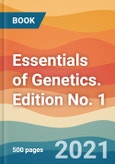Table of Contents
Chapter 1. The concept of Inheritance.A. Early theories of heredity.
B. The Insight of Mendel.
C. Human Pedigrees.
D. The Concept of Mutation.
Chapter 2. Meiosis as the Basis of Mendelian Inheritance.
A. Mitosis and Meiosis.
B. The Chromosome Theory of Heredity.
a. Sex chromosomes and Sex-linkage.
b. Bridges proof of the chromosome theory.
C. Meiosis in Humans.
a. The causes and consequences of aneuploidy.
Chapter 3. DNA is the Hereditary Material.
A. Early evidence: Stadler, Chargaff.
B. The Transformation proof (Avery et al.).
C. The Structure of DNA.
D. Cloning Made Simple (DNA Libraries).
Chapter 4. Gene Expression in Prokaryotes.
(The Central Dogma).
A. One gene – enzyme (Beadle and Ephrussi).
a. Genes encode protein.
b. The structure of proteins.
B. Mutations result in changes in protein sequence.
C. Colinearilty of the gene and protein.
D. DNA->RNA->Protein.
a. The messenger hypothesis.
b. The basic mechanics of transcription.
E. Working Out the Code (Crick, Brenner, Barnett, Watts-Tobin).
a. The basic mechanics of translation.
F. The Lac Operon.
Chapter 5. Gene Expression in Eukaryotes.
A. Splicing: Introns and Exons.
B. The Eukayotic Promoter.
C. The Basics of Transcriptional Control.
Chapter 6. The Isolation and Characterization of Mutants.
A. Yeast: Cell Cycle Mutants.
B. Drosophila: Early Embryogenesis: Nusslein-Volhard.
C. Arabidopsis: Flower Structure.
Chapter 7. Mutational Analysis.
A. The Meaning of Dominance and Recessivity.
B. The Complementation test.
C. Epistasis and Pathway Mapping.
D. Suppression.
E. The Use of Mosaics.
Chapter 8. Mapping.
A. Classic Recombination Mapping.
B. The concept of DNA Polymorphism.
C. RFLP and SNP Mapping.
(The concept of PCR).
D. Positional Cloning.
Chapter 9. Functional Genomics.
A. The Structure of Genomes.
(Repetitive DNA, Heterochromatin).
B. The Structure of Chromosomal Organelles.
C. Gene Families and Homology Searches.
D. Genome Projects.
Chapter 10. How Genomes Change.
A. Mutations and Mutagenesis.
B. Transposons.
C. How Much Variability Is There?.
D. Population Genetics Made (very) Simple.
E. Genetics and Evolutionary Theory.
Appendix: Genetics and History.
A. The Re-Discovery of Mendel.
B. The Columbia Fly Room.
C. The American Eugenics Movement.
D. Elucidating the Structure of DNA.
E. The “Politics of Recombinant DNA”.
F. The Understanding of the Oncogene and Tumor Suppressor Genes.
G. Cloning Mammals.
H. The Odd story of “Adaptive Mutation”








